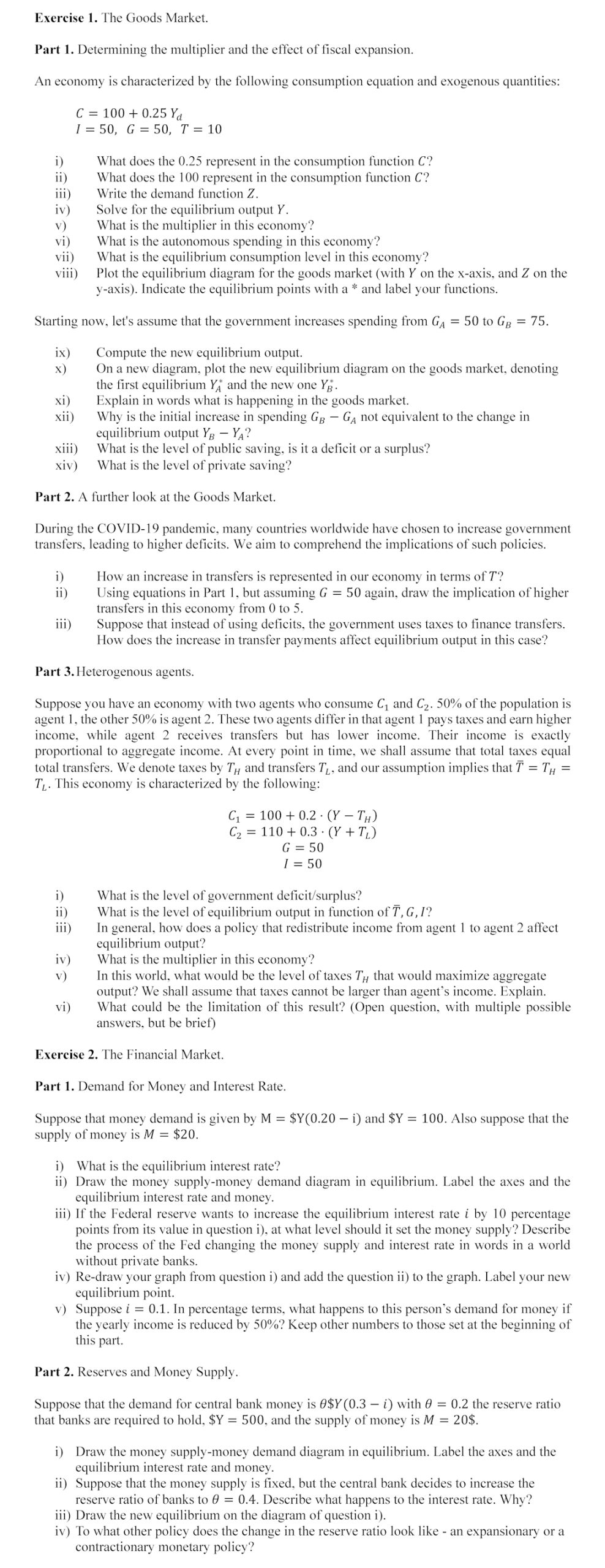
Exercise 1: The Goods Market
Part 1: Determining the multiplier and the effect of fiscal expansion
An economy is characterized by the following consumption equation and exogenous quantities: C=100+0.25Y, I’=50, G=50, T=10
- What does the 0.25 represent in the consumption function C?
- What does the 100 represent in the consumption function C?
- Write the demand function Z.
- Solve for the equilibrium output Y.
- What is the multiplier in this economy?
- What is the autonomous spending in this economy?
- What is the equilibrium consumption level in this economy?
- Plot the equilibrium diagram for the goods market (with Y on the x-axi: y-axis). Indicate the equilibrium points with a * and label your functions. and Z on the
- Starting now, let’s assume that the government increases spending from G, = 50 to G = 75. Compute the new equilibrium output.
- On a new diagram. plot the new equilibrium diagram on the goods market. denoting the first equilibrium Y, and the new one Yj.
- Explain in words what is happening in the goods market.
- Why is the initial increase in spending Gz — G4 not equivalent to the change in equilibrium output Yz — ¥,?
- What is the level of public saving, is it a deficit or a surplus?
- What is the level of private saving?
Part 2: A further look at the Goods Market
During the COVID-19 pandemic, many countries worldwide have chosen to increase government transfers, leading to higher deficits. We aim to comprehend the implications of such policies. i) How an increase in transfers is represented in our economy in terms of T?
- Using equations in Part 1. but assuming G = 50 again. draw the implication of higher transfers in this economy from 0 to 5.
- Suppose that instead of using deficits, the government uses taxes to finance transfers. How does the increase in transfer payments affect equilibrium output in this case?
Part 3: Heterogenous agents
Suppose you have an economy with two agents who consume C; and C,. 50% of the population is agent 1. the other 50% is agent 2. These two agents differ in that agent 1 pays taxes and earn higher income. while agent 2 receives transfers but has lower income. Their income is exactly proportional to aggregate income. At every point in time. we shall assume that total taxes equal total transfers. We denote taxes by Ty, and transfers T,.. and our assumption implies that T = T, = T,,. This economy is characterized by the following: € =100 +0.2- (Y —Ty) €, =110 +03- (Y +T,) G =50 =50
- What is the level of government deficit/surplus?
- What is the level of equilibrium output in function of T, G, I?
- In general, how does a policy that redistribute income from agent 1 to agent 2 affect equilibrium output?
- What is the multiplier in this economy?
- In this world., what would be the level of taxes Ty that would maximize aggregate output? We shall assume that taxes cannot be larger than agent’s income. Explain.
- What could be the limitation of this result? (Open question. with multiple possible answers, but be brief)
Exercise 2: The Financial Market
Part 1: Demand for Money and Interest Rate
Suppose that money demand is given by M = $Y(0.20 — i) and $Y = 100. Also suppose that the supply of money is M = $20.
- What is the equilibrium interest rate?
- Draw the money supply-money demand diagram in equilibrium. Label the axes equilibrium interest rate and money.
- If the Federal reserve wants to increase the equilibrium interest rate i by 10 percentage points from its value in question i), at what level should it set the money supply? Describe the process of the Fed changing the money supply and interest rate in words in a world without private banks.
- Re-draw your graph from question 1) and add the question ii) to the graph. Label your new equilibrium point.
- Suppose i = 0.1. In percentage terms, what happens to this person’s demand for money if the yearly income is reduced by 50%? Keep other numbers to those set at the beginning of this part. and the v
Part 2: Reserves and Money Supply
Suppose that the demand for central bank money is 8$Y (0.3 — i) with 6 = 0.2 the reserve ratio that banks are required to hold, $Y = 500. and the supply of money is M = 20$.
- Draw the money supply-money demand diagram in equilibrium. Label the axes and the equilibrium interest rate and money.
- Suppose that the money supply is fixed. but the central bank decides to increase the reserve ratio of banks to 8 = 0.4. Describe what happens to the interest rate. Why?
- Draw the new equilibrium on the diagram of question i).
- To what other policy does the change in the reserve ratio look like – an expansionary or a contractionary monetary policy?